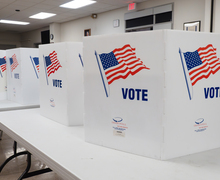SU hosts 6th annual disability-devoted comic con
Corey Henry | Staff Photographer
Leroy Moore (left) and Keith Jones spoke at a panel on Krip-Hop, a form of hip-hop that features the work of people with disabilities.
Participants from across the country and of all abilities attended panels, participated in workshops and took photos at a fully-accessible photo booth on Saturday as part of Syracuse University’s sixth-annual “‘Cripping’ the Comic Con,” a symposium on disability rights and culture.
Diane Wiener, who co-created the event, said the convention has four main purposes: to highlight a nuanced, complex and intersectional representation of disability in comic books; to represent the individual with different identities; to open conversations about how to make comic books more accessible; and to make sure people with disabilities are part of the industry both as creators and consultants.
“Depictions of disability empower the disability community if they are nuanced, honest and effective” said Wiener.
Wiener said she first came up with the idea for the convention in 2013 with Rachael Zubal-Ruggieri, a communications coordinator in the School of Education. Wiener is a research professor and the associate director of interdisciplinary programs and outreach at SU’s Burton Blatt Institute and former director of the Disability Cultural Center. The DCC and the BBI’s Office of Interdisciplinary Programs and Outreach hosted the event in the Panasci Lounge at Schine Student Center.
Nancy Silberkleit, co-CEO of Archie Comics, said in one of the convention’s workshops that the structure of comic conventions often inhibit people with disabilities from having a good time at the convention.
Conventions are typically loud and cramped, and they lack adequate seating, Silberkleit said. Saturday’s “CripCon” had a quiet room for people if they needed it, interpreters at every speech and a closed-captioned live stream for individuals watching from their home.
Jason Pittman, writer and illustrator of “The War for Kaleb,” hosted a booth on anxiety disorders at the convention. He said knew he had to attend “CripCon” as soon as Wiener invited him.
In his critically acclaimed comic book, the main character Kaleb is followed around by two imaginary superheroes, one “light” and one “dark,” that represent how it feels to have anxiety or an anxiety disorder. Pittman said the book came from personal experiences of dealing with anxiety and his love for comic books.
Pittman said he attends many conventions, but that he had the most meaningful conversations about anxiety at “CripCon.”

The sixth annual “‘Cripping’ the Comic Con” was held in the Panasci Lounge on Saturday. Corey Henry | Staff Photographer
Another workshop at the convention was focused on Krip-Hop, a form of hip-hop that features the work of people with disabilities. Leroy Moore and Keith Jones, creators of Krip-Hop Nation — a traveling Krip-Hop group — spoke at the panel. Jones produced a track using his iPad in real time, cutting samples together to create a new beat. Moore shared some lyrics he had written, and the participants wrote some lyrics of their own.
“We want to flip the notion that we’ve always been oppressed” said Moore. “It’s not a pity party.”
Wiener said she hopes participants feel completely included at the convention. She said the con is “crip space” where people with disabilities don’t have to explain themselves or feel different.
One convention attendee who identified herself as the Transmobile Avenger said that people spend a lot of time trying to describe her disability. Saturday, she felt like she didn’t have to explain herself.
“I have the power to move freely through space whether that be on wheels or in flight,” the Transmobile Avenger said.
Published on April 14, 2019 at 10:54 pm
Contact Patrick: pjlineha@syr.edu





